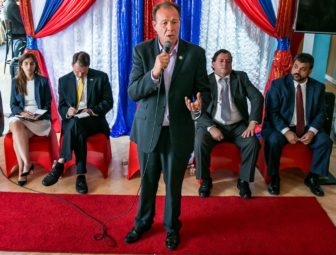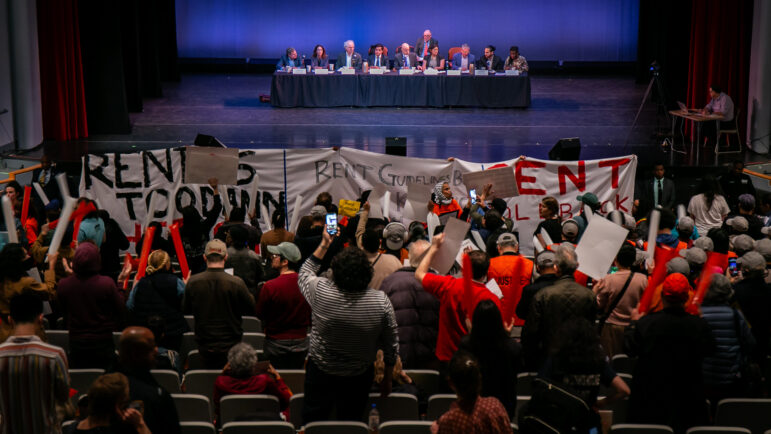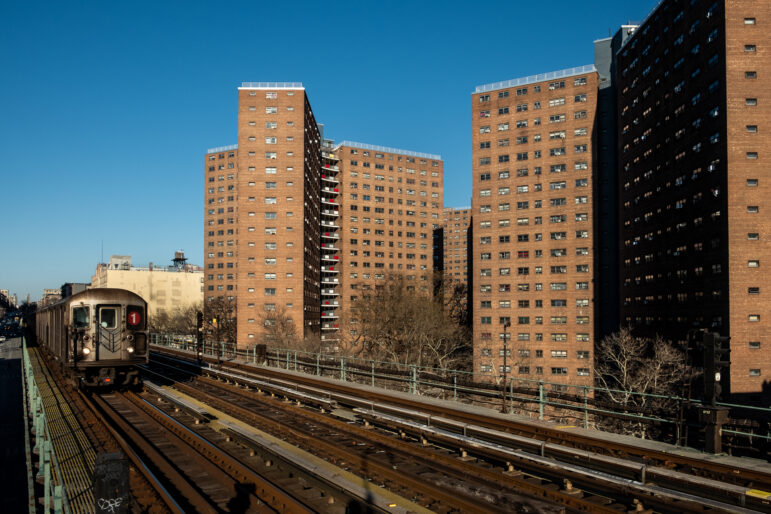The clock is ticking for the New York State Public Campaign Financing and Election Commission to come up with a set of recommendations for a voluntary campaign contribution matching system by December 1. As it works on a tight deadline toward that goal, it is sifting through every detail, from the rate of the match to the state’s contribution limits and how program compliance will be enforced.

Office of the Governor
There seems little disagreement with the thrust of the governor’s proposal, but there are differences of opinion over key details.
The clock is ticking for the New York State Public Campaign Financing and Election Commission to come up with a set of recommendations for a voluntary campaign contribution matching system by December 1. As it works on a tight deadline toward that goal, it is sifting through every detail, from the rate of the match to the state’s contribution limits and how program compliance will be enforced.
As part of the deliberation process, the commission is using the New York City Campaign Finance Board’s system—in its 30th year—as well as Gov. Andrew Cuomo’s Good Government Ethics Reform bill in the executive budget as jumping-off points for a discussion that will be on display Monday as the commissioners meet publicly to discuss their views; unlike earlier hearings, no testimony will occur. (Details of the meeting are here.)
While commending the governor’s proposal for a voluntary matching system on the state level, many experts have also suggested that Cuomo’s blueprint requires significant changes to be successful. And though the lessons learned over three decades of the Campaign Finance Board in New York City are bountiful, the commissioners and those who have been called in to inform them are both drawing and expanding on the city’s program to better fit the intricacies of the state.
The issues are complex but many experts have poured thought into how best to create a successful system.
“There are some tweaks we are suggesting,” says Alex Camarda, senior policy advisor for Reinvent Albany, which has produced 18 recommendations for the new system.
The match
The New York City Campaign Finance Board’s program offers public matching funds to candidates who choose to participate in the program. So long as they meet threshold private fundraising requirements and agree to spending limits, participating candidates receive matching funds for donations from city residents.
The matching ratio has risen from 1:1 on contributions up to the first $1,000 per contributor in 1989, to the current rate of 8:1 on the first $175 per contributor for City Council and borough president, and on the first $250 for other offices.
 Read Part 1 of City Limits in-depth look at the move toward public financing of New York State campaigns.
Read Part 1 of City Limits in-depth look at the move toward public financing of New York State campaigns.
In order to qualify for matching funds, candidates have to reach thresholds including raising a certain dollar amount and collecting a minimum number of qualifying donations. The specifics depend on the office sought, and sometimes include a requirement for in-district contributions.
One thing that’s up in the air on the state level is the ratio of the match. Cuomo has proposed a 6:1 match on the first $175 of each eligible contribution by New York State residents for candidates who meet the thresholds. While the Brennan Center for Justice recommends at least a 6:1 match on the first $200 of eligible contributions and also maintains that the match should only be provided for contributors from within New York State, it says an even higher match ratio of 8:1 should be made available for in-district contributions in legislative races “to further incentivize candidates to reach out to the people they seek to represent,” according to Joanna Zdanys, counsel for the Brennan Center’s Democracy Program.
Jay Jacobs, a commissioner appointed by Cuomo, said in an interview with City Limits in September that he wants the match to apply only to in-district contributions for legislative races, and he also suggested providing a higher match for low-income districts.
He said although he first looked at public financing of elections as “just a one-size-fits-all statewide program,” he has heard arguments from people, including some voices from upstate, that “different districts have different average median incomes, so the standard that you set …is going to have a different result in an area that has a lower income than it will in an area that has a higher income. And if you’re going to have a truly meaningful campaign finance program … it still has to be a progressive one in that you perhaps give a higher matching amount, higher than a 6:1, maybe even 12:1 or possibly more.”
There are questions about how that would work, and while Zdanys says her organization hasn’t seen a concrete proposal that does this, she contends that the New York City program has both some of the wealthiest and lowest income districts in the country “and it has shown that even applying the small requirements across the board that it still achieves the goal of giving candidates a way to fundraise from everyday New Yorkers.”
Meanwhile, Reinvent Albany’s t 18 recommendations include a provision to match only small contributions rather than the first $175 of larger contributions. It contends that the governor’s bill would match the first part of contributions as high as $6,000 in each of the primary and general elections and that doesn’t do enough to incentivize small-dollar fundraising.
Camarda says that even in the 2017 Council race, program participants still tried to raise the largest contributions possible, knowing that the first $175 of donations—no matter how big the total contribution was—would be matched.
“Why would you start with small contributions when you’re getting a match on the larger ones anyway?” he asked.
Michael Malbin, director of The Campaign Finance Institute and a professor of political science at Rockefeller College of Public Affairs and Policy at the University at Albany SUNY, questioned in his prepared testimony for the New York City hearing on Sept. 10 whether Reinvent Albany’s proposal would give candidates enough money to voluntarily join the system, but Camarda says the state might look to Montgomery County, Md. as one example of how to incentivize raising small amounts.
Combined with low contribution limits, the county scales up its 6:1 match so that the first dollars of a small contribution are matched at the highest ratio. For instance, in a race for county executive, the first $50 of a contribution is matched 6:1; the second $50 is matched 4:1, and the last $150 is matched 2:1. There is a similar structure in place for City Council races.
Lower limits
While the governor has proposed lowering contribution limits for both participants and nonparticipants, there has been some discussion as to whether tightening rules for nonparticipants falls under the commission’s purview.
Still, experts have reiterated the importance of lowering contribution limits for all candidates and have called for additional restrictions on contributions from entities other than individuals.
“Publicly financed candidates will not raise and spend money in a vacuum; they will do so alongside competitors who currently can raise enormous sums of money from large donors—as much as $69,700 to a candidate for statewide office, $19,300 to a state Senate candidate, and $9,400 to a state Assembly candidate in an election cycle,” according to the Brennan Center’s prepared public comments before the commission. “Leaving these limits undisturbed for traditionally funded candidates will hamstring the public financing system by disincentivizing candidates from opting in.”
The Brennan Center calls on lower contribution limits for all candidates but argues that there should be different limits for program participants and non-participants given the benefit that participating candidates receive to further incentivize fundraising from small donors.
Others argue that while the governor’s proposal to lower contribution limits is a step in the right direction, it must also tamp down on the appearance of “pay-to-play” politics by enacting stricter rules on entities doing business with the state.
Cuomo’s proposal bans individuals or entities bidding for a state contract from contributing to the officeholder overseeing the bidding agency or a candidate for that office, from the time the offer is submitted until it is awarded and then for a year after the contract is won. But Citizens Union argues that the restriction is limited to a short period of time and a select number of elected officials and candidates, while allowing those participating in long-term contracts to freely contribute to campaigns.
The organization recommends a regulation based on the law in New York City, where there are very low contribution limits for entities “doing business” with the city. Those contributions are not matchable and those doing business with the city are tracked in a database.
Other limits should be placed on corporations and their subsidiaries, treating them as a single entity with regard to contribution limits, according to Citizens Union, which includes unions in this recommendation. It also recommends that contributions made to “housekeeping” accounts for political parties be used strictly for maintenance and construction of party headquarters and that transfers to candidates from party committees, as well as contributions to party committees, be further limited.
Reinvent Albany, for its part, recommends banning corporate campaign contributions entirely and making contributions from contractors, bundlers and intermediaries, state grant recipients, unions, clients of lobbyists and candidate and party committees ineligible for matching funds, in addition to other restrictions already in the governor’s proposal.
The group also calls for limiting candidates’ use of war-chests—money accumulated by a candidate over time—which is particularly pertinent on the state level where there are no term limits. While Cuomo’s proposal requires participants to return the portion of past contributions above the limits to donors or give it to the state’s public financing fund, the organization says a better solution would be to replicate a New York City bill that requires candidates to receive written permission from donors before transferring their funds and to terminate any committees not related to the office they are campaigning for, returning any remaining untransferred contributions to the finance fund.
Incentivizing participation
Unless there is robust participation in the state’s matching system it will fail to reduce the role of big money in the system and the appearance of corruption that creates. There are several elements of a system that can either make or break participation, and experts have pointed to spending limits and qualifying thresholds as two of them.
While the Brennan Center argues that public financing should be capped at an amount that balances the need for keeping spending at a reasonable level and providing candidates enough support, it calls for no spending limits.
“To reflect the realities of campaigning in a world of unlimited independent expenditures, candidates should be allowed to continue to raise and spend without limit, subject to the contribution limits that apply to publicly financed candidates and other program requirements,” the organization’s planned public testimony says. “Public financing should be a floor that boosts candidates, not a ceiling that limits them.”
Richard Briffault, Joseph P. Chamberlain professor of legislation at Columbia Law School, pointed in his prepared testimony to the commission to the fact that Supreme Court decisions have guaranteed privately funded candidates and interest groups the right to unlimited spending on campaigns. He concluded that “the Commission ought not to require candidates to accept a spending limit as a condition for receiving public funds” despite the fact that most public funding programs do.
“Even without a spending cap, public funding can still advance the goals of increasing small-donor participation, increasing competition, and offsetting the power of big donors,” he argues.
While experts agree that qualifying thresholds are necessary to ensure funds are provided to candidates with a base of support and to maintain public trust in and support of the system, several have noted that fewer than one-third of the 2018 candidates in New York State would have qualified for matching funds under the governor’s proposal and recommend lowering it considerably.
Jacobs, in his argument for progressive match rates, said it all comes down to participation.
“The idea, remember, is to get people to want to participate in a system which has significant enough funding possibilities, and in order to do that if you have thresholds that are too high you’re never going to get to it. You’re going to end up in those districts not having participants.” He added: “Not that I look to challenge incumbents, but frankly there are areas where the incumbents get good resources but a challenger doesn’t.”
Needed: Just enough enforcement
“When it comes to a campaign finance system, the only way to sell it to the public is to say we will watch every penny like it’s ours,” says Blair Horner, executive director of New York Public Interest Research Group, but he noted that, “How you do that, I think, is going to be a big problem for [the commissioners].”
While the governor has proposed a campaign finance board within the state Board of Elections, several experts have opposed this concept and insisted that an independent entity be established to oversee the program.
“We want to have an independent enforcing agency and if it needs to be more user-friendly for candidates, then it should be more user-friendly,” Horner says, noting that he doesn’t necessarily buy that NYC’s system is overly onerous.
Many candidates complain that New York City’s enforcement system is too much of a “gotcha” game that requires expertise and resources in order to comply. Councilman Robert Holden, for example, said that during his 2017 race for his seat his campaign had a proof made of a window sign just in order to see the colors. Since the proof didn’t include the required “paid for by” disclosure, his campaign got called in to explain the receipt.
“They kind of didn’t understand,” he said.
Several experts have pointed to the public financing system in Connecticut as a friendlier model that New York State might draw on.
According to a Brennan Center report, Connecticut’s State Elections Enforcement Commission is known for “being supportive and committed to minimizing undue administrative burdens” on candidates, in a system that has grown to a record 335 candidates receiving funds in 2018.
The system restricts post-election audits to no more than half of legislative campaigns, selected by lottery (weighted by recency of any past audit. All statewide office campaigns get audited. By contrast, New York City audits all campaigns.
“People can trust that they’re not going to trap you like a bug under a jar,” says Michael Kink, executive director of the Strong Economy For All Coalition, adding “I think all of this works better if you actually help people comply.”
This is the second article in a three-part series about the campaign finance system. Read the rest of the series here. The reporting is supported by Solutions Journalism. City Limits is solely responsible for the content.









One thought on “Debate Over Fine Points of Campaign-Finance System as Deadline Nears”
Pingback: 10.15 political law links | Political Activity Law/Political Law/Election Law